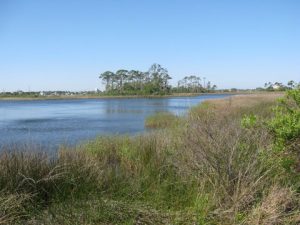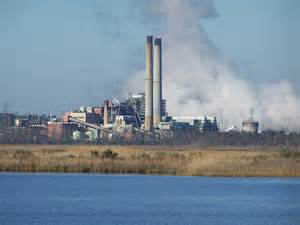In our series Water, the Magic Molecule we have done lessons that have covered several topics concerning water.

Image: Florida Atlantic University
– We know that water is a polar molecule, and because of this can dissolve most organic and inorganic compounds that are essential for moving nutrients around in our bodies.
– We know that water moves around our planet in what we call the water cycle. Water evaporates from the sea, condenses into clouds when it cools, rains onto the land, and flows back to the sea. All water that has been on our planet is still here and we encounter it within different parts of this cycle during our lives.
– We know that as it flows over the surface of the Earth heading back to the sea, that it forms landscapes that allow plants and animals to live. Creeks, streams, rivers, lakes, ponds, bays, springs, and oceans as well as canyons, bluffs, seeps, sinks, coastal plains, are all made from flowing water.
– We know as water flows over the landscape it dissolves minerals as it erodes the rocks and makes the water saltier as it heads towards the ocean – salinity. We understand that as water gets to the ocean it becomes much more saline and changes the plants and animals that live there. We also discussed how plants and animals deal with the dehydration caused by living in salty water.
– We discussed the need for water that all plants and animals have. Why they need it and how much to drink.
– And last week we looked at why plants and animals living in water do not dissolve as rocks and minerals do. Not all compounds dissolve in water.
That’s a lot.
But as we get to the end of this school year, we are going to look at another part of the water story. The part that, though there is a lot of it on our planet – and we all need it – the amount of good quality is changing – and this is because of us. And the distribution of this water on the planet is changing as well – and this is because of us also. But let’s look at water quality first.

Good water quality means different things to different folks. Is the water good enough to drink and is it good enough to swim in are two different things. All of you are, at some point today, going to go to the sink and turn on the water.
Some will shower with it – and we usually do not think about water quality when showering.
Some will use it to boil an egg – and we usually are not concerned about the water quality of the tap water to do this.
Some will pour a glass of water to drink – and some will be concerned about this. Is the water safe enough to drink? Some prefer to use a water filtration system with their drinking water because they are concerned about the safety of it. What is it about the water that would require some to use a filtration system? And what does the filtration system do?

Well… if you think about what we have learned, we know that water dissolves most compounds and the remaining elements are then dissolved in the water. All water has some compounds in it, but in the last one hundred years or so, humans have put new compounds into the environment, which are dissolved in the water, and we may drink them. A lot of them are not healthy for us, and so we must remove them before we drink. Hence the filtration system.
What are these compounds that lower our drinking water quality?
All sorts.
At the beginning of the 20th century there was a need for more food to feed a growing world. To do this we cleared a lot of land for farming and added compounds to help the crops grow. Fertilizers are like food for the plants, but they only eat so much. If you give them too much the remaining that is not eaten will wash away when we sprinkle the field, or it rains. These fertilizer compounds are then dissolved by the water and (if not removed by either the Earth or our filtration system) are present in the drinking water.

Then there is the problem when you have huge fields of food, other creatures (pests) come to feed on it as well. We do not want them to eat our food, so we spray compounds on the food to keep the pests from eating this. Some of these compounds have heavy metals in them that are not good for us. And, like the fertilizers, they wash off and can be found in our drinking water if not removed.
Then there is industrial processing. We have factories all over the country that process, and produce, materials we need. Plastics, gasoline, meat factories processing chicken, beef, pork, automobiles, furniture, appliances, tennis shoes, you name it – we make it. In each of these processes we produce all sorts of waste products that we USE to dump into the water. As you can imagine, there were a LOT of different compounds we have been adding to our water supply over the last one hundred years, and these have been turning up in our drinking water. We now have a federal law that does not allow industrial processing to dump their wastewater directly into the drinking water supply. They must treat it first and things have improved, but there are still products from the past out there, and there are still small amounts from the processing that still reach it – that stuff has to go somewhere.

Photo: Flickr
Then there are microorganisms. Small bacteria and other creatures that can make us sick. Some of these come from the processing of food, where these organisms multiple. And then there is our sewage. Every human will have to go to bathroom. This sewage has a lot of bacteria in it. Some of them are harmless, some cause disease. Where does the sewage water go?
For those on public sewer systems, the water heads to the public sewer processing plant. Here, the sewage is treated before it is discharged into the environment. These sewage plants do a good job with treatment and monitor the water to make sure the process is working. But they do have problems. A big one is what we are flushing down the drain. You might remember that fats and oils do not dissolve in water. When we pour grease down the drain it clogs the pipes and causes the sewage to backflow coming out into the street, and eventually into our waterways BEFORE we had a chance to treat it.


Other things we pour down the drain can cause clogs as well. Flushable wipes can be flushed – but they do not dissolve like toilet paper and cause large clogs. And believe it or not, milk is a problem. They do not recommend pouring milk down the drain.
Others are not on the sewer system, but rather flush their commodes into a septic tank. By design, the waste is treated within the tank and drains through pipes into a drain field in our yard. If the system is functioning properly, they work fine. Another key part is that the drain field must be sand that is porous enough to allow draining. If hard packed clay, it will not work as well. Periodic checking, and pumping, of the septic tank should be done to make sure it is working fine. There are also products we flush into the septic that either clogs it (same products) or kills the bacteria treating the waste in the tank – you don’t want to do that. So, septic tank maintenance is important.

Photo: Marine Science Academy Washington High School
It sounds pretty gloomy reading all of this.
It also makes people worried about drinking our water, and they opt for a filtration system.
The thing is there are a lot of things we can do to reduce the problems. We just need to do them. We need to think about what we are adding to our water system and reduce it as much as possible. We also need to monitor our drinking water to make sure the treatment plans we have been doing their job.
ACTIVITY
– Check your yard. Are there any products, or compounds, that rainwater would wash over and contribute to compounds in our drinking water? If so, can you remove them?
– If you are fighting insect pests with these compounds, are there other natural compounds that could be used that would (a) remove the pest problem, and (b) not be as harmful of they reached the water supply? If so, consider using them.
– What are you pouring down your drain? Many of us use cooking oil, or grease. In Pensacola, the ECUA provides 1-gallon containers to pour your grease in. These are found at stations all around the community (including our extension office). You go there, grab a clean container, fill it with your cooking grease and oil over time, return the full one to the station and get a new clean one – Wah-La! We recommend you do that today.
– What about milk? This is a new one. Right now, many are recommending pouring it over your garden. Milk is full of nutrients and compounds that are good for plants.
– If you have a septic tank, consider having it checked and pumped. This should be done every five years.
There is not much we can do to reduce contaminating compounds from industrial processing and agriculture from reaching our water supply. We will have to depend on our business and civic leaders to do this – and we hope they do.
A lot has been done over the last 40 years to clean our water, and many communities have safe drinking water. But there is more we can do. Let’s do it. And don’t forget to drink water today – you need it 😊
AS ALWAYS
HAVE FUN AND STAY SAFE.
 0
0
